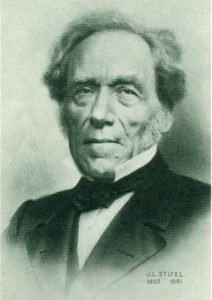

Charleston WV – The following events happened on these dates in West Virginia history. To read more, go to e-WV: The West Virginia Encyclopedia at www.wvencyclopedia.org.
Dec. 13, 1861: The Battle of Allegheny Mountain, one of the bloodiest conflicts of the Civil War’s first year, took place in Pocahontas County.
Dec. 13, 1926: Wheeling radio station WWVA-AM began broadcasting. The 50-watt station operated from the basement of John Stroebel’s house for most of its first year. Stroebel was a physics teacher and wireless pioneer.
Dec. 14, 1910: The accidental death of a Chesapeake & Ohio Railway engineer near St. Albans led to the popular train song “Billy Richardson’s Last Ride.”
Dec. 14, 1857: Coal operator Justus Collins was born. He owned coal mines at Glen Jean and Whipple, and the octagonal Whipple company store survives today as a local landmark.
Dec. 15, 1879: Roman Catholic Bishop John Joseph Swint was born in Pickens. He was responsible for the building of many religious institutions in the Diocese of Wheeling (now the Diocese of Wheeling-Charleston).
Dec. 15, 1967: The Silver Bridge at Point Pleasant collapsed, killing 46 people. The Silver Bridge was opened to traffic on May 19, 1928. The accident led to the passage of legislation for a national bridge inspection and safety program.
Dec. 15, 1972: An explosion at a Weirton Steel coke plant on Browns Island killed 19 men and injured 10 others. It was the worst industrial accident in Weirton’s history.
Dec. 16, 1893: Alexander Martin died at the age of 71 in Greencastle, Indiana. Martin was the first president of the Agricultural College of West Virginia, which was renamed West Virginia University at his recommendation in 1868.
Dec. 16, 1897: The last public hanging in West Virginia occurred in Ripley. John F. Morgan had been convicted of murdering Chloe Greene and two of her three children in the Grass Lick area of Jackson County.
Dec. 17, 1957: The J. L. Stifel & Sons calico plant at Wheeling closed. For most of its history Stifel & Sons produced indigo-dyed prints and drills for clothing manufacturers. At its peak, the plant produced 3.5 million yards of cloth per month.
Dec. 18, 1842: U. S. Senator Nathan B. Scott was born. By 1900, Scott had become one of West Virginia’s four richest and most powerful men.
Dec. 18, 1864: General Harry Hill Bandholtz was born in Michigan. Bandholtz was commander of the federal troops that intervened to end the West Virginia Mine Wars in 1921.
Dec. 18, 1816: Lewis County was formed. It was named for Colonel Charles Lewis, killed at the Battle of Point Pleasant.
Dec. 19, 1794: A 40-acre tract of George Clendenin’s land was selected as the site of Charlestown, later renamed Charleston. Clendenin, born in Augusta County, Virginia, in 1746, was one of the first settlers in the Kanawha Valley. Through Clendenin’s influence the Virginia Assembly authorized the formation of Kanawha County from parts of Greenbrier and Montgomery counties in 1789.
Dec. 19, 1832: The town of Ripley received its charter. It was probably named for Harry Ripley, a popular circuit-riding Methodist minister who drowned in Mill Creek in 1830.


